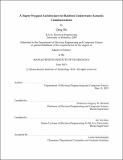| dc.contributor.advisor | Uri Erez. | en_US |
| dc.contributor.author | He, Qing, Ph. D. Massachusetts Institute of Technology | en_US |
| dc.contributor.other | Massachusetts Institute of Technology. Dept. of Electrical Engineering and Computer Science. | en_US |
| dc.date.accessioned | 2012-12-13T17:12:52Z | |
| dc.date.available | 2012-12-13T17:12:52Z | |
| dc.date.copyright | 2012 | en_US |
| dc.date.issued | 2012 | en_US |
| dc.identifier.uri | http://hdl.handle.net/1721.1/75455 | |
| dc.description | Thesis (S.M.)--Massachusetts Institute of Technology, Dept. of Electrical Engineering and Computer Science, 2012. | en_US |
| dc.description | This electronic version was submitted by the student author. The certified thesis is available in the Institute Archives and Special Collections. | en_US |
| dc.description | Cataloged from student-submitted PDF version of thesis. | en_US |
| dc.description | Includes bibliographical references (p. 135-136). | en_US |
| dc.description.abstract | Oceans cover about 70 percent of Earth's surface. Despite the abundant resources they contain, much of them remain unexplored. Underwater communication plays a key role in the area of deep ocean exploration. It is also essential in the field of the oil and fishing industry, as well as for military use. Although research on communicating wirelessly in the underwater environment began decades ago, it remains a challenging problem due to the oceanic medium, in which dynamic movements of water and rich scattering are commonplace. In this thesis, we develop an architecture for reliably communicating over the underwater acoustic channel. A notable feature of this architecture is its rateless property: the receiver simply collects pieces of transmission until successful decoding is possible. With this, we aim to achieve capacity-approaching communication under a variety of a priori unknown channel conditions. This is done by using a super-Nyquist (SNQ) transmission scheme. Several other important technologies are also part of the design, among them dithered repetition coding, adaptive decision feedback equalization (DFE), and multiple-input multiple-output (MIMO) communication. We present a complete block diagram for the transmitter and receiver architecture for the SNQ scheme. We prove the sufficiency of the architecture for optimality, and we show through analysis and simulation that as the SNQ signaling rate increases, the SNQ scheme is indeed capacity-achieving. At the end, the performance of the proposed SNQ scheme and its transceiver design are tested in physical experiments, whose results show that the SNQ scheme achieves a significant gain in reliable communication rate over conventional (non-SNQ) schemes. | en_US |
| dc.description.statementofresponsibility | by Qing He. | en_US |
| dc.format.extent | 136 p. | en_US |
| dc.language.iso | eng | en_US |
| dc.publisher | Massachusetts Institute of Technology | en_US |
| dc.rights | M.I.T. theses are protected by
copyright. They may be viewed from this source for any purpose, but
reproduction or distribution in any format is prohibited without written
permission. See provided URL for inquiries about permission. | en_US |
| dc.rights.uri | http://dspace.mit.edu/handle/1721.1/7582 | en_US |
| dc.subject | Electrical Engineering and Computer Science. | en_US |
| dc.title | A super-nyquist architecture for rateless underwater acoustic communication | en_US |
| dc.type | Thesis | en_US |
| dc.description.degree | S.M. | en_US |
| dc.contributor.department | Massachusetts Institute of Technology. Department of Electrical Engineering and Computer Science | |
| dc.identifier.oclc | 818359416 | en_US |
